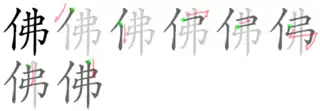佛
| ||||||||
Translingual
| Stroke order | |||
|---|---|---|---|
 | |||
Han character
佛 (Kangxi radical 9, 人+5, 7 strokes, cangjie input 人中中弓 (OLLN), four-corner 25227, composition ⿰亻弗)
References
- KangXi: page 99, character 4
- Dai Kanwa Jiten: character 517
- Dae Jaweon: page 208, character 11
- Hanyu Da Zidian (first edition): volume 1, page 140, character 3
- Unihan data for U+4F5B
Chinese
| simp. and trad. |
佛 | |
|---|---|---|
| alternative forms | ||
Glyph origin
| Historical forms of the character 佛 | ||||
|---|---|---|---|---|
| Shuowen Jiezi (compiled in Han) | Liushutong (compiled in Ming) | |||
| Small seal script | Transcribed ancient scripts | |||
 |
 | |||
| ||||
|
References: Mostly from Richard Sears' Chinese Etymology site (authorisation),
| ||||
Phono-semantic compound (形聲, OC *bɯd) : semantic 亻 + phonetic 弗 (OC *pɯd).
Etymology 1
Ji (1998v7) considers it likely borrowed from Iranian (compare Sogdian 𐼾𐼴𐽂𐼷 (pwty), 𐫁𐫇𐫤𐫏 (bwty /Pute, Bute, βute/), Middle Persian [Book Pahlavi needed] (bwt'), 𐫁𐫇𐫤 (bwt /But/), Parthian 𐫁𐫇𐫎 (bwṯ /But, Butt/)), ultimately from Sanskrit बुद्ध (buddha, “awakened, enlightened”, past passive participle), whence also 佛陀 (MC bɨut̚ dɑ), but the Chinese morpheme 佛 is not a direct contraction or clipping of the latter.
Pronunciation
Definitions
佛
Compounds
|
|
|
Etymology 2
| For pronunciation and definitions of 佛 – see 彿 (“resembling, like, as if”). (This character, 佛, is the simplified and variant traditional form of 彿.) |
Notes:
|
Pronunciation
Compounds
|
Pronunciation
Definitions
佛
- † Alternative form of 弼 (bì, “to assist”).
- 佛時仔肩,示我顯德行。 [Pre-Classical Chinese, trad.]
- From: The Classic of Poetry, c. 11th – 7th centuries BCE, translated based on James Legge's version
- Bì shí zǐjiān, shì wǒ xiǎn déxíng. [Pinyin]
- Assist me to bear the burden [of my position],
And show me how to display a virtuous conduct.
佛时仔肩,示我显德行。 [Pre-Classical Chinese, simp.]
- a surname
- 佛肸以中牟畔。 [Classical Chinese, trad. and simp.]
- From: The Analects of Confucius, c. 475 – 221 BCE, translated based on James Legge's version
- Bì Xī yǐ Zhōngmù pàn. [Pinyin]
- Bi Xi is in rebellion, holding possession of Zhongmu.
Pronunciation
References
- “佛”, in 漢語多功能字庫 (Multi-function Chinese Character Database), 香港中文大學 (the Chinese University of Hong Kong), 2014–
Etymology 6
Dialectal pronunciation of 服 (fú). Popularized by the streamer Sun Xiaochuan.
Pronunciation
Japanese
| 仏 | |
| 佛 |
Definitions
| For pronunciation and definitions of 佛 – see the following entry. | ||||||
| ||||||
| (This term, 佛, is an alternative spelling of the above terms.) |
Korean
Etymology
From Middle Chinese 佛 (MC bɨut̚).
| Historical Readings | ||
|---|---|---|
| Dongguk Jeongun Reading | ||
| Dongguk Jeongun, 1448 | 뿌ᇙ〮 (Yale: ppwúlq) | |
| Middle Korean | ||
| Text | Eumhun | |
| Gloss (hun) | Reading | |
| Hunmong Jahoe, 1527 | 부텨 (Yale: Pwùthyè) | 불〮 (Yale: pwúl) |
Pronunciation
- (SK Standard/Seoul) IPA(key): [puɭ]
- Phonetic hangul: [불]
Old Japanese
Etymology
Most likely from Proto-Koreanic *Pwutukye (“Buddha”).
Noun
佛 (poto2ke2) (kana ほとけ)
Descendants
- Japanese: 仏 (hotoke)
References
- Jin'ichi Konishi (2017), Aileen Gatten, Nicholas Teele, transl.; Earl Roy Miner, editor, A History of Japanese Literature, Volume 1: The Archaic and Ancient Ages (Volume 4935 of Princeton Legacy Library), Princeton University Press, →ISBN, page 415
Vietnamese
Han character
佛: Hán Việt readings: phật (
佛: Nôm readings: phật[1][2][3][4][6]
Compounds
References
- Nguyễn (2014).
- Nguyễn et al. (2009).
- Trần (2004).
- Bonet (1899).
- Génibrel (1898).
- Taberd & Pigneau de Béhaine (1838).
